Log prices are on the rise as demand for firewood grows – what you need to know
If you’re planning to stock up on firewood this winter, you might want to be aware of this
If you’re a design hobbyist or a professional designer looking for interior design software to help you plan out an apartment, you may be wondering how to decide which apartment planner is the best choice.
There are lots of different options out there and many of them have similar benefits. For hobbyists, you’re probably looking for something affordable and easy to use. The professionals amongst you will most likely want something with more complex tools.
In our guide, we’re going to take a look at 6 of the best apartment planners out there and help you decide which is the best apartment planner tool currently available.
The best interior design software that we’ve used is Planner 5D. It’s perfect for designing apartments as it allows you to modify even the smallest architectural details such as partitions, stairs, and windows.
You can also do the same for exteriors including pools and landscaping.
This design tool is fully immersive and you can build both 2D and 3D models. You can design them from scratch or take advantage of more than 4,000 pre-built templates. Once you’ve created your designs you can print them in photorealistic formats to show to others.
The program is very versatile and can be operated via any web browser. If you’d rather download it as a native app then it’s also available for iOS, MacOS, Windows, and Android.
Planner 5D can capture interior plans using snapshots and then convert these into HD visualizations. These images are very realistic and include shadows, colours, and different light angles.
The software also comes with a library of over 5,000 pre-built items which you can use to find the right items for all of your projects.
Planner 5D has several different price tiers which makes it an affordable option for both individuals and businesses.
The basic version doesn’t cost anything but the premium version costs £5.00 ($5.70) a month billed yearly at £59.99 ($69.00). For twice the price you can subscribe to the commercial version which is £10.00 ($11.50) a month also billed yearly at £119.99 ($136.00).

Roomstyler is an easy-to-use interior design software that allows you to upload pre-existing floor plans or use pre-loaded templates. There’s a gallery of interior finishes for you to choose from and you can insert windows, doors, and walls.
The interface for this software is user-friendly and you can view your 3D image and your plan simultaneously. You can see different views by moving the camera around your plan.
You can also make use of over 120,000 brand-name items such as garden tools and kitchen appliances which can be inserted into your apartment models.
This is a free room design app that can be used without even signing up. If you do sign up, you can then upload your designs to Facebook to share with other people.
Another nice feature is the ‘available for purchase button’. If you like any of the items or décor you’ve used in your room layout model, you can click this button to purchase them.
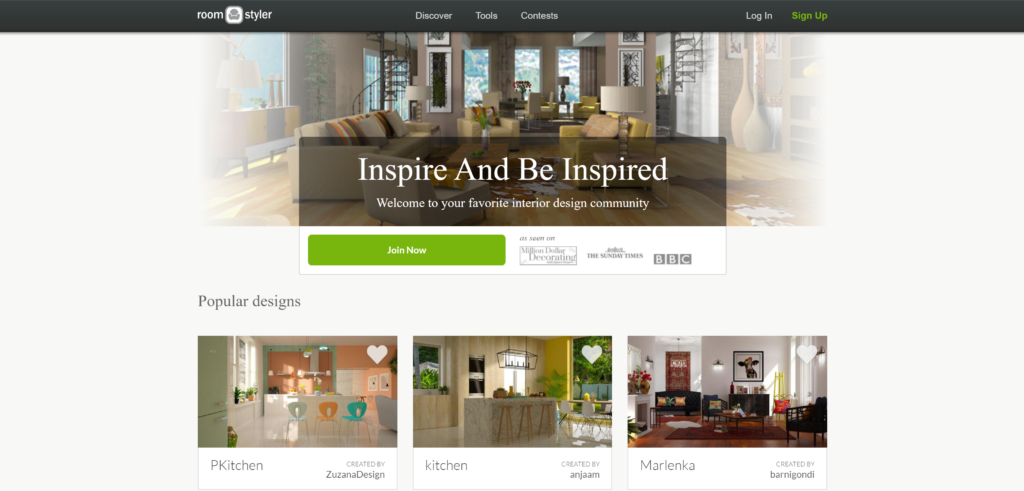
Floorplanner is an online room design software that can be operated via any web browser. It’s ideal for both companies and individuals. This software is perfect for planning apartments as you can design single rooms as well as entire floors.
It also allows you to design your room layouts so that you can plan how your furniture will fit into them.
This online room planner gives you great opportunities for collaboration. You can edit and present your ideas to colleagues and clients online via the cloud.
Floorplanner is simple to use and has a fluid operating system that doesn’t seem to experience many glitches. This makes it a good option for beginners who don’t have experience with BIM or CAD systems.
Floorplanner offers a free design software option but it is fairly limited. If you’d rather access the version with full features then the prices start at £4.00 ($5.00) a month for individuals and £50.00 ($59.00) a month for businesses.
Considering what’s included in the packages, this is one of the most affordable interior design tools on the market.
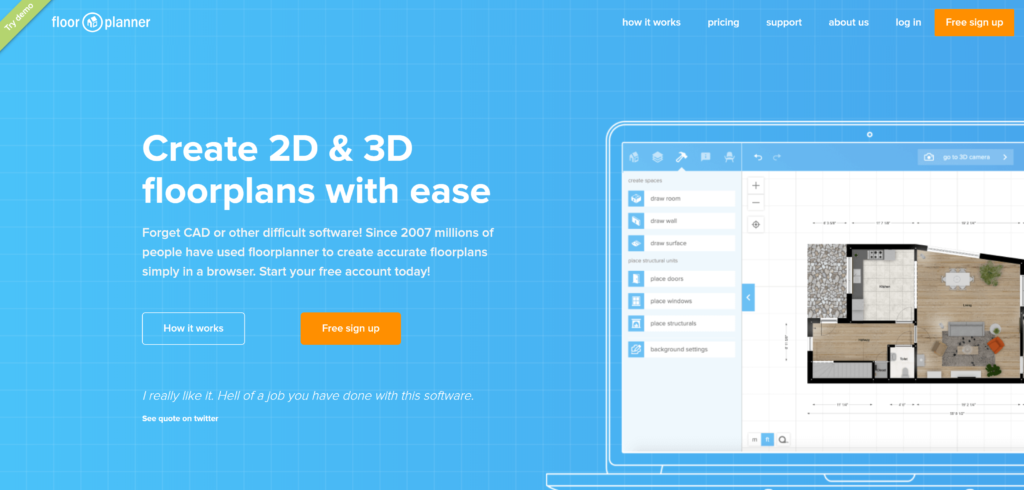
HomeByMe is a browser-based interior design software that can also be downloaded as an app on both Android and iOS. This means that you can plan out your designs wherever you are, although the interior design tool is cloud-based so you do need to stay connected.
The basic version is a free room design software that isn’t as limited as many other free versions. For instance, when using HomeByMe’s free version you can work on three different projects at the same time.
The free option is suitable for hobbyists but probably wouldn’t be of much use to professional interior designers. This is because low-resolution images take a very long time to render and a large watermark is pasted across them.
HD images are rendered quickly but the free option limits you to a small number of these. However, you are given an unlimited number of low-resolution images.
It may not be the best interior design software available but it does handle complex designs well. You can use HomeByMe to draw up a simple floor plan or make more complicated designs.
As well as the free option, HomeByMe has a monthly subscription option and a one-time purchase option.

DreamPlan is one of the best home design software tools when it comes to power and simplicity. Room planning is easy and it has lots of innovative features to help you fully realise your design ideas.
This interior design software can be used on both Mac and Windows. You can plan buildings on multiple levels and choose from a library of 3D models to furnish them. You can also use various building materials to modify and alter your designs on the inside and out.
DreamPlan is one of the best room design apps for built-in video tutorials. When using the room design app just look out for the blue camera icon which will lead you to a helpful tutorial video.
If you want to upload an existing floor plan then Trace Mode will come in handy. You can upload your room design into the software and then turn it into a 3D model.
In terms of price, this room design software costs £35.00 ($40.00) for home licensing and £45.00 ($50.00) for commercial licensing. This makes it an affordable option for both commercial interior design and amateur room designs.
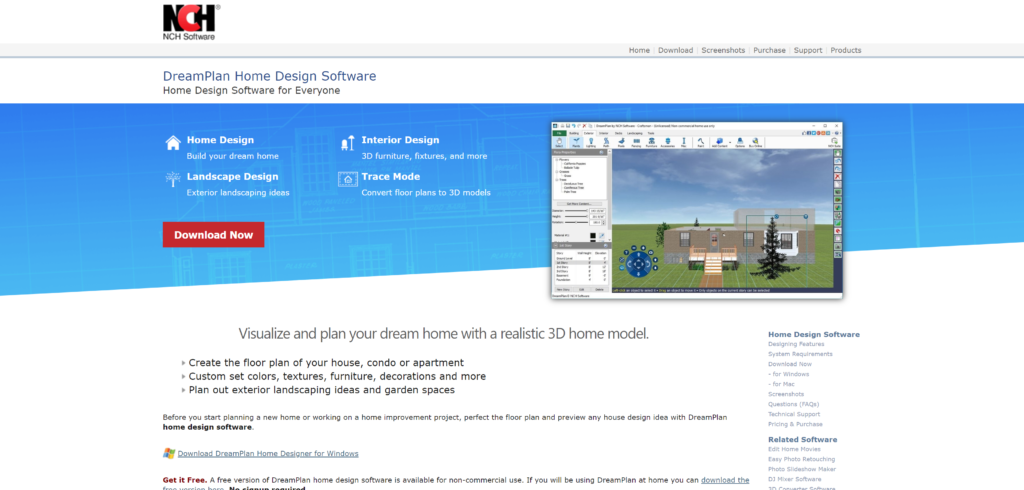
Home Designer Suite is one of the best interior design software programs for professionals but it does have a fairly steep learning curve which can make it difficult to use for an amateur room designer.
This interior design software allows you meticulously plan, edit precisely, and customize all your ideas down to the last detail. Many processes are also automated which makes the creative process more straightforward.
You can create rooms with lots of detail and use its floor planner to plan out your rooms accurately.
Home Designer Suite has many advanced features and gives you complete control over your new space or existing design project.
Although it may seem very complex to use at first the automated processes and aesthetically pleasing interface help a great deal with this.
Home Designer Suite is also available for Windows and Mac and you can use the free trial period to see if it’s right for you. The subscriptions come in various price tiers depending on the option you choose.

The free version of Planner 5D is much better than the free versions offered by many other companies. It has a huge catalogue of items and templates for you to use, and you can create as many projects as you like. If you want to unlock the full version with access to the entire catalogue then the paid versions start at very affordable prices.
Planner 5D allows you to create your own furniture designs and then upload them to the program. For example, you could make custom-tailored tables in different colours, sizes, and shapes.
Interior design software is not just good for interior designers but it’s also very beneficial for clients. It allows designers to create digital models to show to clients so that they can give their approval. This means that clients can be a bigger part of the design process than they were in the past.
Anyone with a camera can take a picture. But capturing the perfect photograph is an art form. It takes skill, practice, and patience to create beautiful images that capture a moment in time.
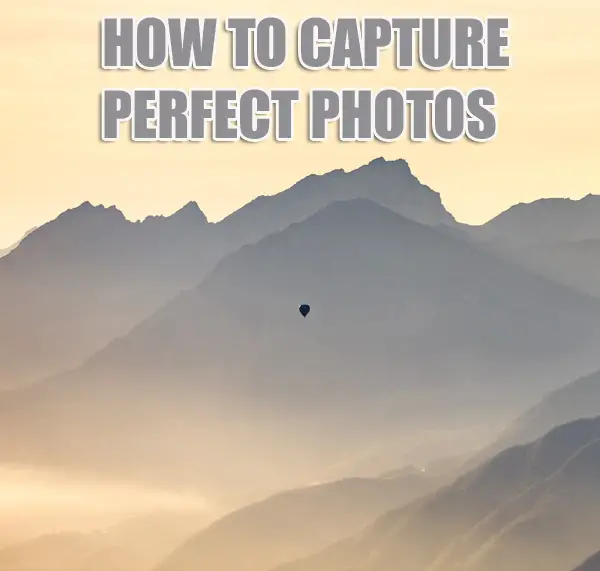
In this blog post, we will share 10 tips for capturing perfect photographs every time.
To capture the perfect picture every time, use natural light, get close to your subject, find a unique perspective, keep your composition simple, play with lines and shapes, pay attention to your backgrounds, use leading lines to guide the eye, and create a sense of depth.
Capturing the perfect photo can be a challenge, even for experienced photographers. However, there is one foolproof way to ensure that your photos turn out looking great every time: use natural light.

By taking advantage of the sun’s rays, you can create stunning images that are full of contrast and detail. And because natural light is free, you can save money on expensive lighting equipment. You also don’t need expensive cameras to take remarkable images with natural light.
Best of all, natural light is flattering to both people and objects, making it the ideal choice for capturing pictures of your family, friends, and favorite subjects.
So next time you’re reaching for your camera, make sure to take advantage of the beautiful light provided by Mother Nature.
When it comes to getting the perfect photo, there is no substitute for getting up close and personal with your subject.

This allows you to shoot with a wide aperture, which gives you a shallow depth of field and helps you to focus on your subject.
It also allows you to capture more detail and avoid distracting background elements. Of course, getting close to your subject can sometimes be difficult, but that’s where creativity and perseverance come in.
If you’re willing to experiment and shoot from different angles, you’ll find that you can get the perfect photo every time. So don’t be afraid to get up close and personal with your subject.
It’s the best way to ensure that you’ll always capture the perfect photo.
Anyone can snap a picture, but it takes a true artist to capture a perfect photo. One of the keys to success is finding a unique perspective.

We all see the world through our lens, and by learning to focus on what makes our perspective special, we can learn to take truly stunning pictures. Here are a few tips to help you get started.
First, take some time to examine your work with a critical eye. What do you like about your photos? What makes them stand out? Second, experiment with different techniques, and don’t be afraid to try something new.
Third, learn from your mistakes and keep practicing until you get the results you want. With these tips in mind, you’ll be well on your way to taking perfect photos every time.
When it comes to capturing the perfect image, sometimes less is more. A busy composition can be distracting, drawing the viewer’s eye away from the subject of the photo.

By simplifying your composition, you can create a more elegant image that highlights the main focal point.
This can be achieved by removing clutter from the foreground and background, or by choosing a more minimalistic approach when framing the shot.
By streamlining the composition, you can create images that are more visually appealing and better suited to conveying your intended message.
So next time you’re behind the camera, remember that sometimes simplicity is key to taking great photos.
Traditional photography involves point-and-shoot cameras and relies on objects in the frame to create an image. However, this isn’t the only way to take pictures.
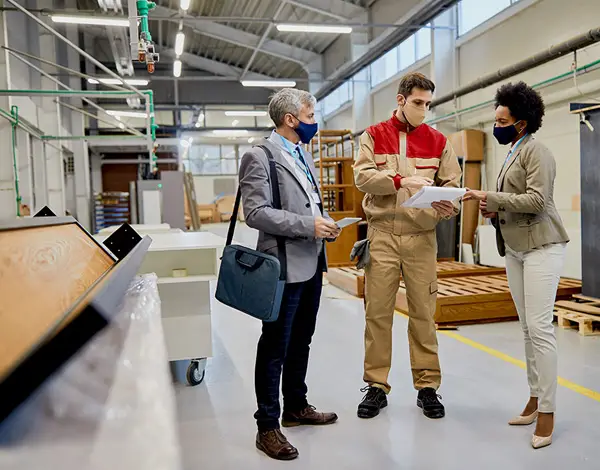
By playing with lines and shapes, you can create interesting compositions that are perfect for capturing abstract photos.
Lines can lead the eye around the frame, and shapes can add contrast and visual interest. By experimenting with these elements, you can produce stunning results that go beyond the traditional snapshot.
So next time you’re behind the camera, don’t be afraid to get creative with your composition. You might just capture the perfect photo.
Leading lines are one of the most important compositional elements in photography. By using lines to guide the eye, photographers can control how viewers see their shots and emphasize certain elements within the frame.

Leading lines can be created by a variety of means, including roads, fences, power lines, and even the horizon.
When used effectively, leading lines can create a sense of depth and movement within a photo, drawing viewers into the scene. They can also be used to lead viewers toward a particular subject or point of interest.
By understanding how to use leading lines, photographers can capture more powerful and evocative shots.
Every photographer knows that the key to capturing a great photo is paying attention to the background. A busy or cluttered background can distract from the main object of the photograph, making it appear smaller or less important.

Conversely, a simple background can make the object appear more striking and vibrant. Paying attention to the background also allows you to capture interesting juxtapositions or patterns that can add another layer of meaning to your photos.
So next time you’re photographing a friend or family member, take a moment to look around and choose a background that will help make your photo perfect.
When you’re shooting a photo, one of the things you want to consider is how to create a sense of depth.

This can make your photos more interesting and engaging, and it’s also perfect for capturing candid moments. For example, if you’re taking a photo of a person, try to include something bright in the background.
This could be the sun shining through a window or even a lamp on a nearby table. The contrast between the bright background and the person in the foreground will help to create a sense of depth in your photo.
By including elements like this in your photos, you’ll be able to perfectly capture those candid moments.
When it comes to taking pictures, Negative space is your best friend. This is the area around your subject matter – and by including more of it in your image, you can create a cleaner, more minimalist composition that is sure to capture the perfect shot every time.
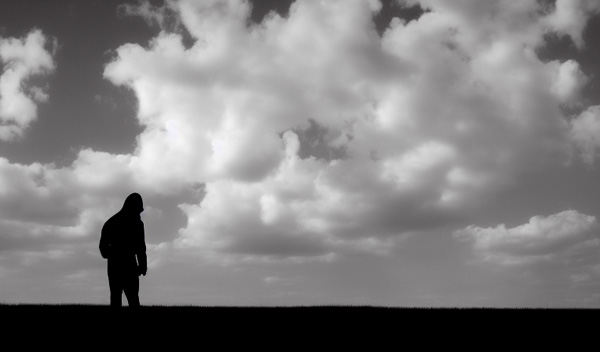
Not only does negative space help to simplify an image, but it can also be used to great effect to highlight your subject matter.
By leaving more negative space around your subject, you can create a sense of focus and ensure that your image is well-balanced.
In addition, negative space can be used to great effect in images that feature strong light and shadow contrast.
By including more negative space in these images, you can help to emphasize the drama and intensity of the scene. So next time you’re behind the lens, remember to leave some room for negative space – it could be the key to taking your image from good to great.
Anyone who’s ever tried to capture the perfect shot knows that it’s not always easy. Sometimes it takes shooting a hundred pictures before you get the right one.
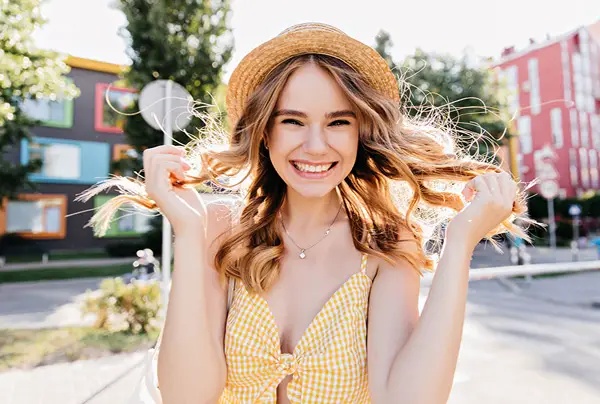
And even then, there’s always the possibility that you could have done something just a little bit differently to make it even better. That’s why I believe that having fun and experimenting is the key to capturing great pictures every time.
If you love what you’re shooting, then chances are good that your excitement will come through in your work. And even if you don’t get the perfect shot every time, you’ll at least walk away with some great memories (and maybe a few good laughs).
So next time you’re out shooting, remember to relax and enjoy yourself. You might just be surprised at what you end up with.
These are just a few tips to help you get started. The best way to improve your photography skills is to practice, experiment, and have fun! We hope these tips inspire you to get out there and start capturing some amazing photographs.
Click the following link to learn what to do if you hate taking pictures of yourself.
